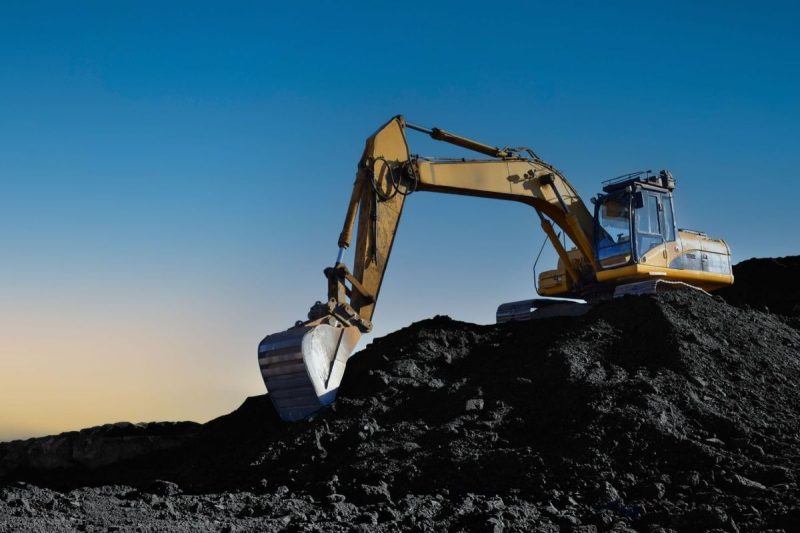For thousands of years, coal has been an important source of heat and energy.
The fossil fuel played a crucial role in the Industrial Revolution, and today it’s the largest source of energy for electricity generation in the world — in total, coal generates over one-third of the world’s electricity.
But is coal’s role in the energy landscape fading? Maybe. However, there’s still a case to be made for the world’s dirtiest energy source. While its use has fallen in many countries, demand in others is rising. Additionally, it plays an essential role in steel-making.
Read on to find out how to invest in coal, the coal market outlook, as well as metallurgical and thermal coal stocks and ETFs you can invest in.
In this article
What is coal and what is it used for?
Coal is a hydrocarbon (carbon plus hydrogen), or fossil fuel, that contains the stored energy of prehistoric vegetation. The oldest coal dates back to 360 million years ago, and was formed when swamps and peat bogs were buried due to shifts in the Earth’s tectonic plates. Subjected to pressure and heat deep underground, the plant material in the swamps and bogs underwent a chemical reaction, creating coal.
There are four main categories of coal that are based on the type and amount of carbon in the coal and how much heat energy it can produce.
The most commonly mined classifications are sub-bituminous coal and bituminous coal. Sub-bituminous coal is used primarily as fuel for steam-electric power generation. Bituminous coal makes up more than half of the world’s coal reserves and accounts for a majority of the coal industry.
Bituminous coal is divided into two types: thermal and metallurgical. Thermal coal is used in energy generation for heating, but it is also used for cement manufacturing and other industrial purposes. Metallurgical coal, also known as met coal or coking coal, is used to produce coke, the primary source of carbon used in steelmaking.
Top coal-producing countries
In 2023, the three top coal-producing countries in the world were China, India and Indonesia, which combined represent 70 percent of the record 8.9 billion metric tons of coal production for the year. The US was the fourth largest coal producer in 2023, and saw its production decline by 2.8 percent over the previous year.
The US, Russia, Australia, China and India are the countries with the largest proven coal reserves, representing 75 percent of total global coal reserves. Japan, India, China, South Korea and Taiwan among the largest importers of coal.
Coal industry trends
Global coal demand has been on a declining trend since 2014, especially in Europe and the United States. However, this trend reversed in 2021, according to the International Energy Agency’s (IEA) 2021 coal report. Lower supply and rebounding coal demand in China — the world’s largest consumer — pushed prices for the material to record highs that year.
Russia’s invasion of Ukraine elevated coal demand and prices in 2022 and 2023 as European countries such as Germany and Italy fired up previously mothballed coal plants to make up for sidelined natural gas supply. Coal usage rose by 3.3 percent in 2022 and 2.6 percent in 2023 to reach new all-time highs in both years based on IEA reporting.
The electricity and industrial sectors are the largest end users of coal. The electricity sector alone accounts for two-thirds of coal demand worldwide, making it a main driver of global coal demand trends, explains the IEA.
How much impact the renewable energy transition will have on the global coal market and how soon it will happen will depend on how quickly such policies and technologies are adopted in China and India. China’s electricity sector accounts for one-third of global coal demand, according to the IEA, which states a “recovery in hydropower in China combined with significant expansion of wind and solar is expected to slow the growth of coal power generation globally in 2024.”
Environmental concerns are one of the main reasons some market watchers believe coal’s role in the energy mix is set to fade in the coming years and decades. Both mining coal and burning it for energy are problematic, with two of the key issues being pollution and greenhouse gasses.
Many countries have laid out plans to phase out coal in the near to medium term, including Germany (which has the largest fleet of coal-fired plants in Europe), Canada, the UK, Finland, France, Chile, Ireland, Israel, New Zealand, South Africa and Denmark. Belgium has been coal-free since 2016.
During his first term in office, US President Donald Trump sparked hope for a coal industry revival when he pulled the country out of the Paris Agreement, citing his support of the coal sector as one of his reasons for doing so.
Under President Joe Biden, the US rejoined the Paris Agreement. In his first days in office, Biden signed an executive order directing federal agencies to help generate alternative economic activity in regions traditionally dominated by the coal industry, such as Kentucky and West Virginia. The Biden administration also set a lofty goal of using 100 percent renewable energy for electricity generation by 2035. In response, many US utilities began moving towards wind and solar power, as well as natural gas.
With Trump back in office in 2025, the US coal industry may see a reversal of Biden’s directives. Leaders in the industry are hopeful that Trump’s pick for Secretary of Energy, Founder and CEO of Liberty Energy (NYSE:LBRT) Chris Wright, and his pick for Secretary of the Interior, North Dakota Governor Doug Burgum, will revive the country’s coal sector.
Coal industry outlook
The investment outlook for the coal industry is dependent on a myriad of factors, including electricity and industrial demand as well as a shift toward renewable energy sources.
Overall, after a mere 0.4 percent increase in total consumption in 2024, demand for coal is set to decline by 0.3 percent in 2025, according to the IEA.
Whether or not coal is here to stay or is facing its demise depends on jurisdiction.
After four years of steady growth, China’s coal usage has begun to slow on economic woes. For thermal coal consumption in China, the agency is projecting a demand growth rate of 0.9 percent in 2024 — the lowest rate since 2015. For 2025, the IEA is forecasting a 1.1 percent decline in demand from the power sector as the transition to renewables continues.
Metallurgical coal demand in the country is expected to remain flat as the real estate sector continues to falter.
While China may have decreased its coal use in an effort to improve air quality, the Asian powerhouse is still one of the world’s fastest-growing major economies and is likely to remain the world’s top coal consumer for years to come.
India is experiencing the greatest growth in coal demand compared to other regions. The IEA estimates that India’s consumption of thermal coal will have increased by almost 10 percent for 2024, while the country’s metallurgical coal consumption is expected to increase by just over 2 percent.
With India growing its coal-fire plant capacity by more than four times its annual average in the past five years and rising demand for thermal and met coal in industrial applications, the IEA projects the country’s aggregate coal demand to rise by 3.1 percent in 2025.
In the United States, coal usage in 2024 remained on par with the previous year, but the IEA expects it will decline by 2 percent in 2025.
Europe is forecast to continue experiencing the greatest decline in coal consumption, particularly from the power sector as the switch to renewable energy and nuclear power intensifies. The IEA predicts a 19 percent drop in coal demand for the region in 2024 followed by a 3 percent decline in 2025.
Looking more specifically at metallurgical coal as a whole, research firm Technavio is reporting that the market will experience a compound annual growth rate of 4.77 percent between 2023 and 2028. The vast majority of this growth — 85 percent — is expected to come from the Asia-Pacific region, particularly out of China, Australia, Indonesia and India.
How to invest in coal
There are a number of entry points for investing in coal, including thermal and metallurgical coal stocks and coal ETFs. Below, we take a look at each of these routes to investing in coal.
Coal stocks
For those interested in investing in coal stocks, there are a number of publicly traded metallurgical, thermal and coking coal companies to choose from. Learn about options for coal stocks listed on the NASAQ, NYSE, TSXV, ASX and LSE below.
Alliance Resource Partners (NASDAQ:ARLP)
Alliance Resource Partners is the largest coal producer in the Eastern United States. With seven underground coal mining operations in Appalachia and the Illinois Basin, this coal company provides thermal and metallurgical coal products to utility, industrial and steelmaking customers on a global scale.
Alpha Metallurgical Resources (NYSE:AMR)
Alpha Metallurgical Resources is a metallurgical coal company that has 21 coal mines across the United States’ Central Appalachia regions of Virginia and West Virginia. The company produces and exports metallurgical products to the global steel industry, with customers in 25 countries.
Arch Resources (NYSE:ARCH)
Arch Resources and its subsidiaries provide metallurgical coal products for the global steel industry and thermal coal for domestic and international power generation markets. Its operations include four metallurgical coal mines in West Virginia, two thermal coal mines in the Powder River Basin of Wyoming and one thermal coal mine in Colorado.
CONSOL Energy (NYSE:CEIX)
CONSOL Energy is a producer and exporter of high heating value bituminous thermal coal for global markets. It owns the Pennsylvania Mining Complex, located in its namesake state’s Greene and Washington counties, which is the largest underground coal mine complex in North America. The company’s Baltimore Marine terminal is one of the largest coal export terminals on the Eastern Seaboard.
Corsa Coal (TSXV:CSO,OTCQX:CRSXF)
Corsa Coal is a metallurgical coal producer with five mines in the US states of Pennsylvania and Maryland. Corsa sells its metallurgical coal products to both domestic and international steel and coke producers.
Glencore (LSE:GLEN,OTC Pink:GLCNF)
Glencore is one of the world’s largest producers and exporters of thermal and metallurgical coal. The company has numerous met coal and thermal coal operations in Australia, Canada, Colombia and South Africa.
Peabody Energy (NYSE:BTU)
Peabody is a leading producer of thermal and metallurgical coal to domestic and global markets. The company’s United States operations are in the states of Colorado, New Mexico, Illinois, Alabama and Wyoming, specifically in Wyoming’s coal-rich Powder River Basin. It also has extensive seaborne thermal and metallurgical coal operations in the Australian states of Queensland and New South Wales.
NACCO Industries (NYSE:NC)
NACCO Industries is the parent company of four separate business units related to natural resource mining and environmental solutions. The company’s North American Coal business unit operates numerous surface coal mines in the US across the states of Mississippi, Louisiana, Texas and North Dakota.
New Hope Group (ASX:NHC)
New Hope is involved in all stages of the coal industry, from exploration and development to production and processing. The company owns interests in two open-cut thermal coal mines in Queensland and New South Wales. Much of its production is shipped to customers in Asia.
Ramaco Resources (NASDAQ:METC)
Ramaco Resources produces premium metallurgical coal products for customers in North America and internationally in approximately 20 countries. The company has nine met coal mines in the Appalachian states of West Virginia and Virginia.
SunCoke Energy (NYSE:SXV)
SunCoke Energy is the largest independent coke producer in the US by annual output. The coal company operates five metallurgical coke plants across Illinois, Indiana, Ohio and Virginia, as well as one in Brazil. SunCoke’s heat-recovery coke-making technology produces stronger coking coal and converts the heat into steam or electricity.
Warrior Met Coal (NYSE:HCC)
Warrior Met Coal is a major supplier of premium metallurgical coal, also known as hard-coking coal, to the global steel industry, particularly in Europe, South America and Asia. The company has two active underground mines based in Alabama, US.
Whitehaven Coal (ASX:WHC)
Whitehaven Coal is a leading Australian metallurgical and thermal coal producer with six mines in the Gunnedah Coal Basin of New South Wales and Bowen Basin of Queensland. The company exports to economies across East and South East Asia.
Yancoal Australia (ASX:YAL)
Yancoal Australia is Australia’s largest pure-play coal producer and one of the largest coal exporters. With a focus on both metallurgical and thermal coal products, the company operates five mines and manages five other projects across the states of New South Wales, Queensland and Western Australia.
Coal ETFs
For those investors interested in how to invest in Coal ETFs, Range Global and VanEck offer coal investment funds.
Range Global Coal Index ETF (ARCA:COAL)
The Range Global Coal Index ETF offers investors exposure to companies engaged in the metallurgical and thermal coal industry, from exploration and development through to production, transportation and distribution. Its top holdings include Warrior Met Coal, Yancoal Australia and Alpha Metallurgical Resources.
VanEck Vectors Coal ETF (ARCA:KOL)
The VanEck Vectors Coal ETF offers a broader global range of exposure to the coal and energy markets. Its constituents are companies with operations in a wide variety of energy sectors, including coal-focused ones such as coal and consumable fuels, coal products, steel and metallurgical coal mining. Top holdings in KOL include freight rail transport company Aurizon Holdings (ASX:AZJ); Exxaro Resources (OTC Pink:EXXAF,JSE:EXX), one of South Africa’s largest coal producers; and the aforementioned Whitehaven Coal.
Securities Disclosure: I, Melissa Pistilli, hold no direct investment interest in any company mentioned in this article.

































